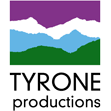Where in the world could you walk down the cobbled streets of 1890s London in the aftermath of some of the most gruesome murders the world has ever witnessed, while at the same time Jimi Hendrix is strumming his guitar just a stone's throw away in the 60s, and less than three hours away, a Charles Dickens novel from the 1830s is being brought to life?
These aren't scenes from the proposed 'Back to the Future' remake. Rather each of these 'only in the movies' moments are currently happening in Ireland, many within walking distance from the other. Currently, the BBC is in Dublin's Clancy Barracks filming Jack the Ripper-based series 'Ripper Street'; Andre 3000 of Outkast fame is portraying Jimi Hendrix before he was famous in 'All Is By My Side' in Dublin city centre and Wicklow; and Kindle Entertainment has begun principal photography in Belfast on 'The Life and Adventures of Nick Nickleby', a modern re-working of the classic Dickens novel.
Our Emerald Isle has more than earned its billing as a prime filming location, having played host to Jim Sheridan's Oscar-winning 'My Left Foot' in 1989; Mel Gibson's Oscar-winning 'Braveheart' in 1995; 'The Count of Monte Cristo' in 2002; HBO series 'Game of Thrones' and many, many more.
While there's no denying Ireland's Section 481 tax incentive is an important element for any production company, we must bestow credit to Ireland's other amenities; such as our land, our historical significance, and our real claim to fame: our people. It is down to these three prominent factors that Ireland, all 81,000 km² of it, has seen a recent surge in period dramas shooting on location.
Over the last five years, our island has provided a home for international production companies shooting such period pieces as 'The Tudors'; 'Camelot'; 'Song for a Raggy Boy'; Angela's Ashes'; and most recently, 'Titanic: Blood and Steel'; 'Ripper Street', 'Game of Thrones' and miniseries 'Vikings'.
What is fantastic [about filming in Ireland] is that film companies don't have to travel huge distances in order to have a wonderful, beautiful cross section of distinctive visually stunning locations
"
Land
No production portrayed our lush greenery better than 'Braveheart', which shot its iconic 13th century battle scenes in the Curragh Plains in Co Kildare, and Sally's Gap in Wicklow.
Ken Loach's 'The Wind That Shakes the Barley', set during the Irish War of Independence (1919-1921) and the Civil War (1922-1923), was filmed in Timoleague and the mountains in Ballyvourney in Co Cork. A number of scenes are set against the backdrop of Cork's grassland, especially the memorable ambush scene, which was shot in the mountains of Ballyvourney.
Edmund Sampson, an Irish-based location manager and a member of the Location Managers Guild, has worked on a number of productions based in Ireland, including period drama 'The Tudors'. The popular series was set in the 16th century, charting the life and losses of Henry VIII, played by Cork-native Jonathan Rhys Meyers. Michael Hirst wrote and executive produced the series, which ran for four seasons.
Sampson said some the key locations used for the Showtime production (BBC and TV3 later aired it in UK/Ireland) were Christchurch Cathedral (Dublin), Dublin Castle, Powerscourt Estate (Enniskerry), and Drimnagh Castle (Dublin). He says the main reason for choosing these locations was because they provided "suitable architecture to the period we were filming in, and they had a good cross section; this is one of the great advantages of filming in Ireland, within a small distance, you have got on your doorstep a mixture between city centre scale locations as well as beautiful countryside."
'The Tudors' production largely took place in Ardmore Studios, based in Wicklow, just outside of Dublin. Sampson continued: "What is fantastic [about filming in Ireland] is that film companies don't have to travel huge distances in order to have a wonderful, beautiful cross section of distinctive visually stunning locations."
Each location mentioned by Sampson offers a completely unique setting, yet most fall within walking distance from each other in Dublin. Christchurch Cathedral, in the heart of Dublin's city centre, is a unique building in what was once considered Dublin's most medieval area. The Cathedral stands alone among an array of modern built buildings, such as the Civic Offices of Dublin County Council and a number of local businesses which have set up in the area. The Cathedral still offers all its original authentic amenities, such as stocks from 1670, and original candlesticks from the 17th century.
Drimnagh Castle, the only castle remaining in Ireland with a flooded moat surrounding it, is located in the Dublin suburb Drimnagh. It is approximately a 15-minute drive from Christchurch Cathedral. The Castle itself is of Norman descent, and today stands alone beside a thoroughly modern primary and secondary school of the same name, surrounded by housing estates and local businesses of Drimnagh.
Sampson also acknowledges Kilruderry House and Gardens, situated near Bray in Wicklow. "Kilruddery worked well for us, it gave us a good cross section, for instance you could be filming in a floral garden setting, or filming in a period room, and then go to a rolling landscape. When you're filming television, you have to do a lot in a day, with feature film you would not move as quickly. In television your page count is higher, so therefore the advantage is you find a visual diversity within a short distance," said Sampson.
Even current production 'Ripper Street' has applied Sampson's 'cross section' theory, having filmed in its Clancy Barracks location in Dublin, Poolbeg Street in the capital's city centre, and the Phoenix Park, which is just a stone's throw away from the Barracks, and home to some of Ireland most historical and significant landmarks such as the Papal cross, Áras an Uactharáin, the Magazine Fort etc.
Historical Significance
Ireland is steeped in Celtic and medieval history. From the Bronze Age, to the Iron Age to the Vikings and Norman invasions in the Middle Ages, Ireland lived through more historic events than many others. But it is thanks to these moments in history we have retained some of the oldest stone buildings, some of the most complex architecture of its time, and some of the most unique castles in the world, allowing our country to act as a chameleon at times.
A recent production 'Titanic: Blood & Steel', the elegant mini-series that portrayed the building of the ship in 1909 and the impact it had on the lives of those involved in its creation, took advantage of a number of Irish historical locations when filming.
Notable areas with historical significance include the Guinness Factory at St James's Gate in Dublin, which still maintains 19th century cobbles at the famous black gates. Henrietta Street, which was once a tenement housing estate for the inner city people of Dublin, was also used as a filming location. Henrietta Street has maintained the four storey Georgian houses, as well as the stone cobbles on street level. The street itself was the subject of a TV3 documentary earlier this year, presented by 'Fair City' actor Bryan Murray, focusing on the history of the tenement houses and the poverty-stricken families that dwelled in them.
'Titanic: Blood & Steel' also used the National Library as a filming location, which was established in 1887, according to cinematographer James Welland, who worked on the series in Ireland.
BBC series 'Ripper Street' is shooting in Clancy Barracks, a real-life former army barracks for Irish soldiers, which is adjacent to Heuston Station and nearby the Phoenix Park. Mark Geraghty, the Irish set-designer behind the impressive 'Ripper Street' set, said choosing the Barracks location was a "no brainer". Geraghty designed his own set buildings and streets around the already existing buildings, which are made of brick from the outside with wooden front doors. The location looks like a building site at the best of times, with many of the surrounding areas derelict remains of former Barracks facilities.
The other location used for the BBC drama, the Phoenix Park, opens out to Chapelizod, a quiet village in the south west if Dublin. The river Liffey runs through it, while the Strawberry Beds and the Memorial Gardens flank either side of the picturesque village. Chapelizod village is the setting of James Joyce's short story 'A Painful Case', taken from 'Dubliners'. Other than the Park, some other attractions in Chapelizod include the church, an original Georgian building located at the River Liffey, grey-brick cottages on hill-tops, and two-storey Georgian houses with all original beaming and grassland still intact.
Adjacent to Chapelizod is the Irish National War Memorial Gardens in Islandbridge, which is home to a memorial for Irishmen who served in the army during World War I. The gardens was also the setting for Queen of England's visit to Ireland last year, and features a number of sights, including two floral gardens, memorial statues, and the River Liffey running the whole way through.
Naoise Barry, Film Commissioner with the Irish Film Board (IFB), says: "It's essential that we preserve our built heritage" as it serves as an "enormous advantage" to the Irish film industry. Barry also acknowledges that "easy and affordable access to publicly and privately-owned film locations needs to be maintained", something in which the IFB plays a role in co-operation with the Film Dublin Partnership and the Network of Regional Film Offices.
The Film Dublin Partnership was established in 2004 by the IFB, and is a support network of 31 public and private sector stakeholders. It is coordinated by the IFB to ensure that Ireland’s capital city remains an attractive base for local and international film and television production. According to Barry, the Network provides an opportunity for consultation, coordination and communication on complex film and television projects that are in need of multiple agency assistance. Key members of this network include Dublin City Council, An Garda Síochána, the Office of Public Works (OPW), and the Dublin Chamber of Commerce.
The public want film and TV drama to provide them with an escape, and period drama can deliver that, by transporting you to another time and place
"
The history of the period dramas themselves drives the production crew’s interest as well as the history of the locations. IFTA-nominated costume designer Lorna Marie Mugan, currently providing the wardrobe for ‘Ripper Street’, says period dramas give a costume designer more licence to be creative: “…because less people understand the period, so you have more control in a lot of respects. You can present your ideas, whereas in contemporary productions everybody would have an opinion. Definitely with period dramas, you have a licence to push the boundaries quite a bit.”
With the success of ‘Downton Abbey’, the ITV series which has scored high ratings in both the UK and the US, there has been a recent surge in period dramas in general. Just last month, BBC comedy ‘Blandings’, set in 1929, wrapped filming in Co Fermanagh. Stars such as David Walliams, Jennifer Saunders and Mark Williams touched down on Northern Irish soil to film scenes.
Prior to this however, Northern Ireland has steadily cemented itself as the king of locations in recent years, with a string of high-profile productions filming in the region. In what is undoubtedly one of the biggest productions this island has ever seen, HBO's 'Game of Thrones' began filming there in 2010, filming two full seasons in Belfast's Paint Hall Studios. The fantasy adventure is due to commence production on season three this month.
Northern Ireland Screen, the North's leading film and television agency which supports, develops and funds productions, was a key player in bringing 'Game of Thrones' to Northern Ireland. Backed by Invest NI and the European Regional Development Fund, NI Screen has overseen every 'Game of Thrones' season as well as a number of other high-profile productions, including BBC series' 'The Life and Adventures of Nick Nickleby' and 'The Fall'.
Northern Ireland Screen’s Head of Marketing Moyra Lock told IFTN part of Northern Ireland’s charm is its historical significance and its array of locations. “Northern Ireland is the most compact 5,196 square miles of back-lot in the world – offering myriad stunning locations from beautiful coastlines to idyllic villages, mountains, glens and loughs, through to urban landscapes and bustling cities with a diverse mix of architectural styles, from Victorian red-brick to 21st century glass and steel,” said Lock.
Several of these “stunning locations” have been used for seasons one and two of ‘Game of Thrones’, and according to Lock “it is expected that some new ones will come on board for season three. It was a specific requirement in ‘Game of Thrones’ that the settings be based on real locations, to get that sense of rugged, earthy authenticity, as well as being able to believe you are in a place that has been there for thousands of years”.
Other Northern Ireland locations used for the series include Castle Ward in Co. Down which was Winterfell; seat of House Stark; Tollymore Forest at the foot of the Mourne Mountains; the Antrim coast including picturesque Ballintoy harbour and the Dark Hedges near Armoy.
The fantasy adventure employed a number of Irish and Northern Irish crew, from hair and makeup professionals to special effects experts. Irish actors who starred in the epic series include Aidan Gillen (Love/Hate, Shadow Dancer) and Liam Cunningham (Titanic: Blood & Steel), while Northern Irish director Brian Kirk (My Boy Jack) was nominated for an IFTA for directing the show.
Fantasy adventures such as ‘Game of Thrones’ and period dramas like ‘Downton Abbey’ have proved popular with Irish audiences. According to Naoise Barry, the public “want film and TV drama to provide them with an escape, and period drama can deliver that, by transporting you to another time and place”. He continued to say hit shows such as ‘Downton Abbey’ (season three is currently in production in the UK) remind us of “just how addictive good television can be”. Barry said Irish period drama ‘The Tudors’ “led the way” in showing us what was possible.
People
No Irish-based production would be possible without the assistance of external sources, such as local authorities, residents, and production crew. A sentiment that is echoed throughout the industry both here and abroad is that Irish people are more accommodating than most when it comes to making things happen.
London-based cinematographer James Welland, who worked in Ireland on period dramas such as ‘Aristocrats’ in 1999, and ‘Titanic: Blood & Steel’ in 2011, said there was a “general willingness to make the production work” when working on location for ‘Titanic’, especially around the Guinness Factory area. He continued: “It’s about is there a willingness to make it work, are you going to be happy filming there, can you close the roads, can you put lights, can you have generators here, can you put cables out, can you do all those little things? I found filming in Dublin on that front to be very helpful. Other countries, you find they're a bit more limiting”.
Irish crews have a reputation overseas that is of a quality standard according to Sampson, who said this is partly down to Irish crews gaining experience on local projects as well as Hollywood blockbusters: “The quality of [Irish] crew is outstanding. I think nearly everybody in Ireland has worked on a major Hollywood blockbuster or a large television drama, so there's that huge experience there, and that has to be very attractive”.
Barry echoes this sentiment: “Irish crew have an excellent reputation. We make a point of reminding foreign producers that all the talent they may need to hire is available here in Ireland. It’s important to remember that big productions like ‘Albert Nobbs’ and ‘The Tudors’ find 90 per cent of their crew locally, including creative heads of department. It’s also important to note that when we offer IFB production funding we contractually oblige the producers to hire Irish crew, including Irish directors on incoming TV drama”.
Organisations like the Cork Screen Commission have a large role to play in marketing Ireland’s locations both locally and abroad. Cork Screen Commissioner Niall Mahoney says the establishment of the Commission “is a real step forward in that direction, having somebody dedicated and experienced at that top level who can reach out directly to companies producers, directors, as well as work very closely with the Film Board and if possible, the Location Managers Guild, so we'd have a seamless approach when people come here [to film].
”Particularly for things like period dramas there are a lot of natural landscapes, because that's what we have to offer here. One of the major strengths are the underused and beautiful locations within easy access of production centres like London, Dublin, Munich, because we have the airport here, and within two hours, you're in most of the locations. It's very important to reach out directly and I think the creation of the Screen Commission is a huge step forward, it's real tangible evidence that of how they're backing the screen industries,” said Mahoney.
For more information on locations in Ireland see IFTN's locations website www.locationsireland.com as well as www.irishfilmboard.ie; www.northernirelandscreen.co.uk and
www.corksreencommission.com
This article is published as part of IFTN’s new www.locationsireland.com monthly Locations Newsletter. To register for the Newsletter, email: emma@iftn.ie









